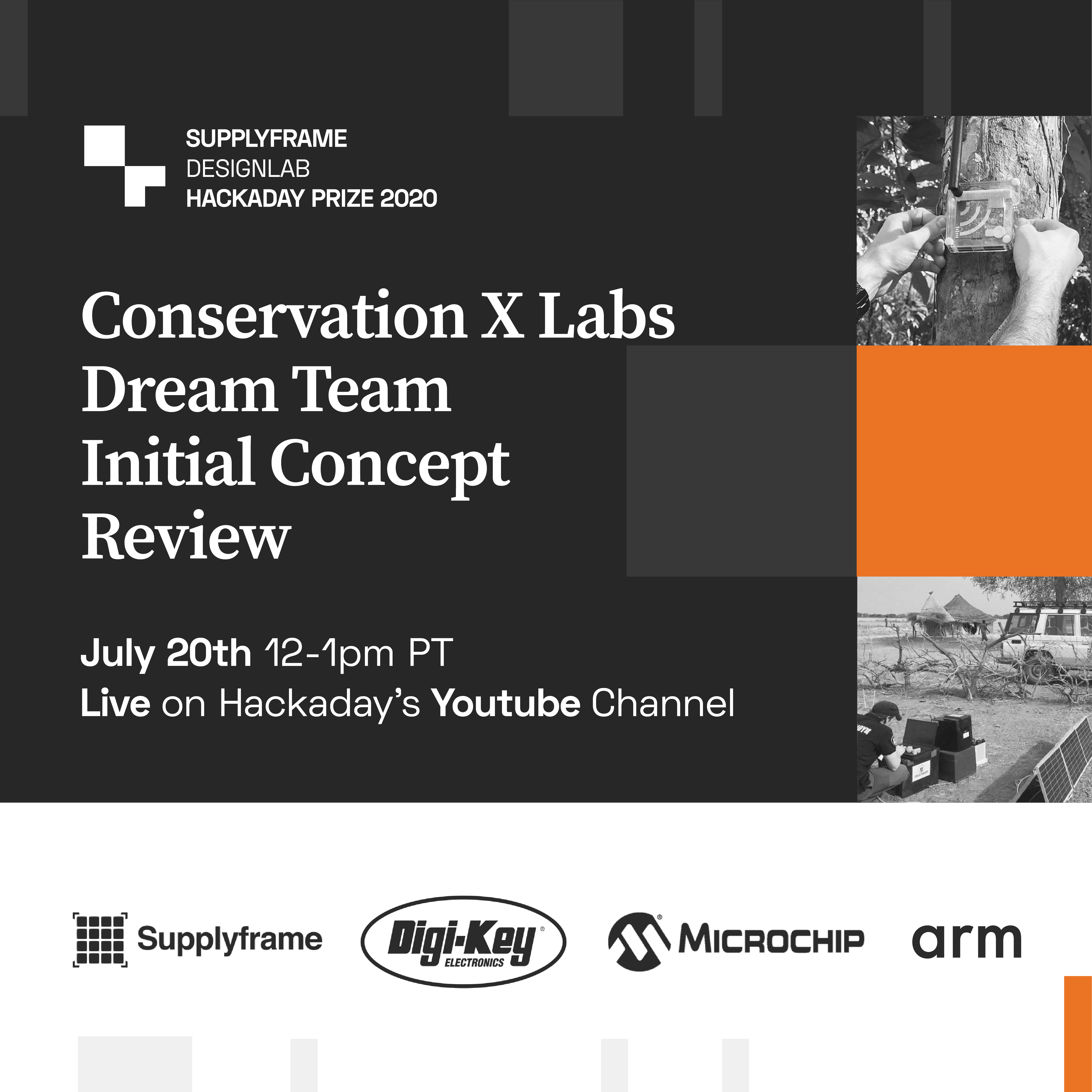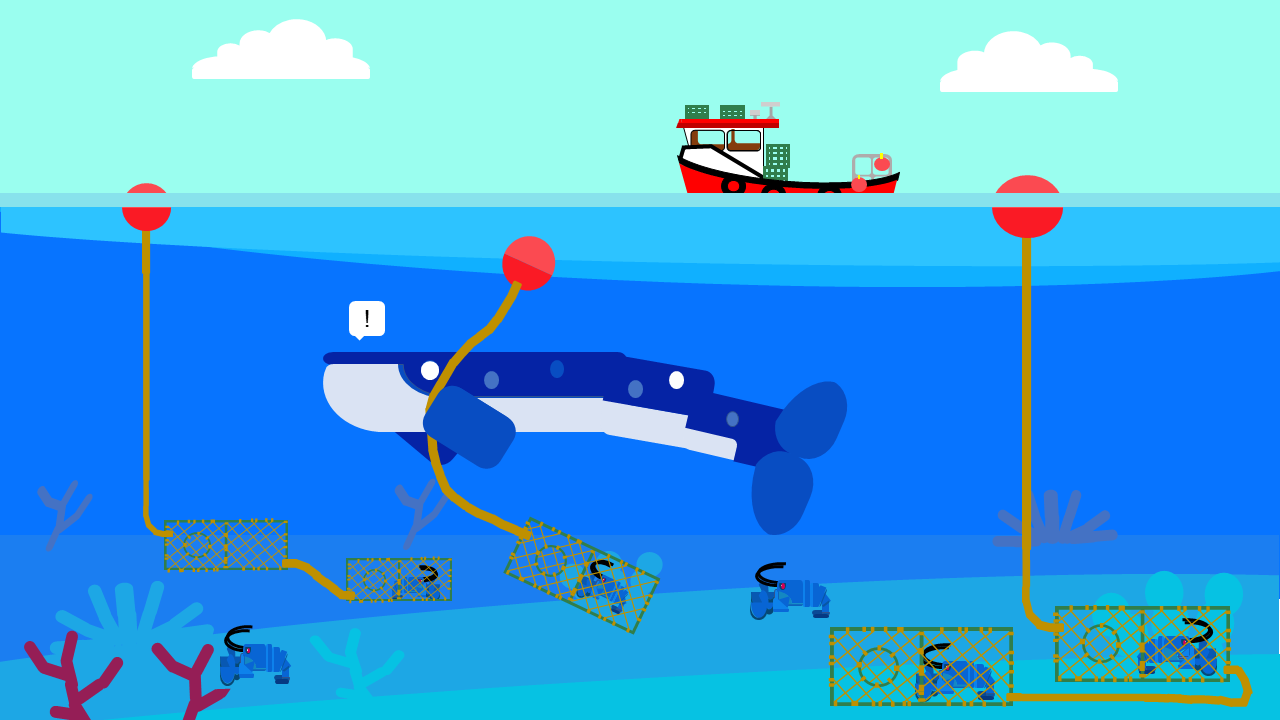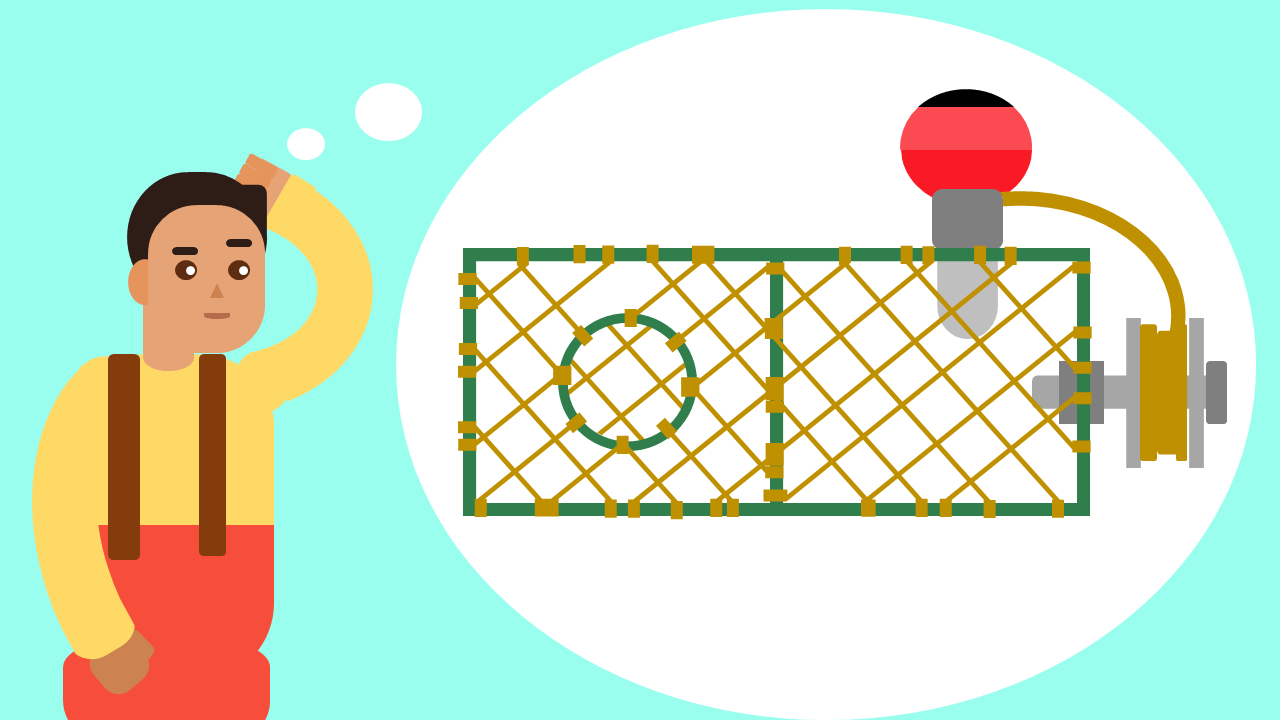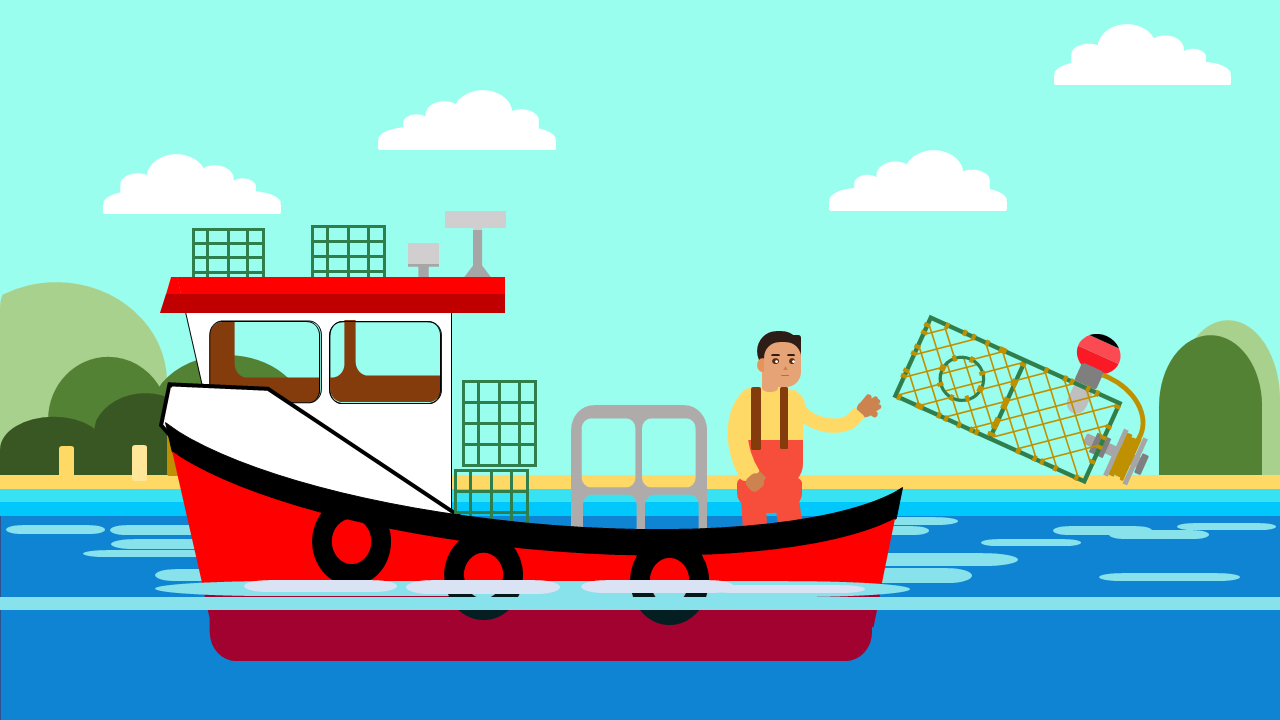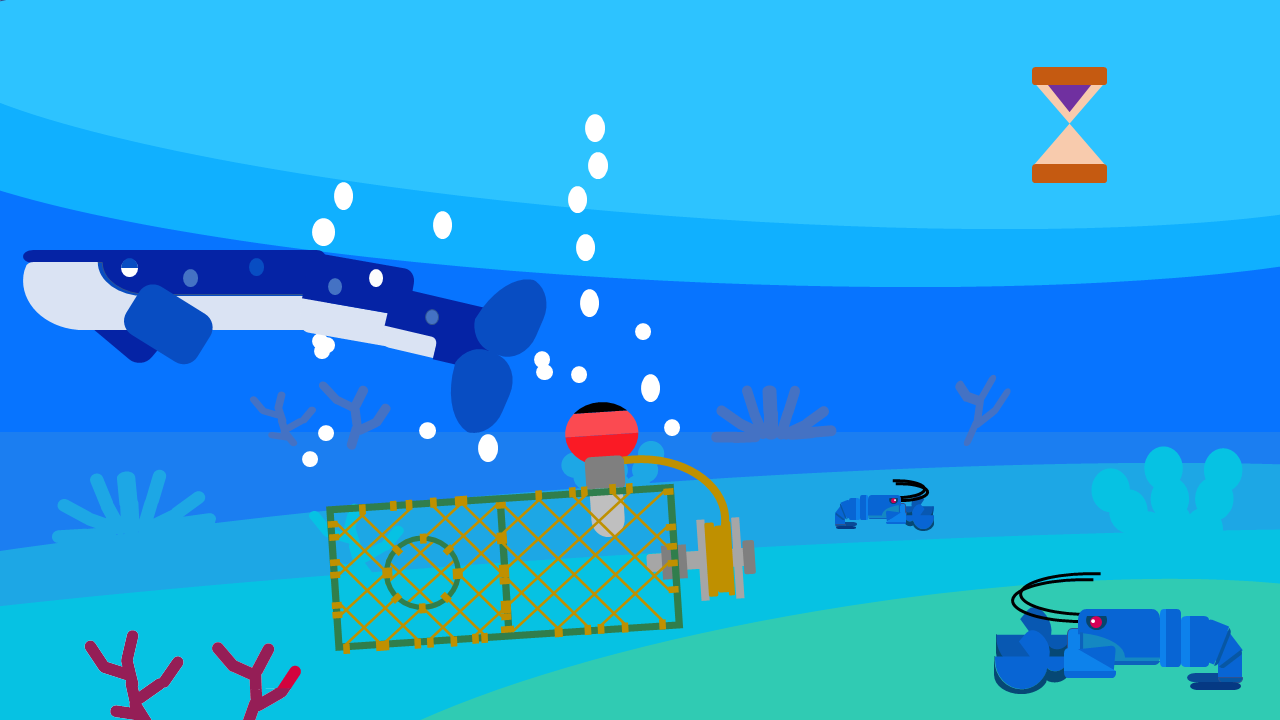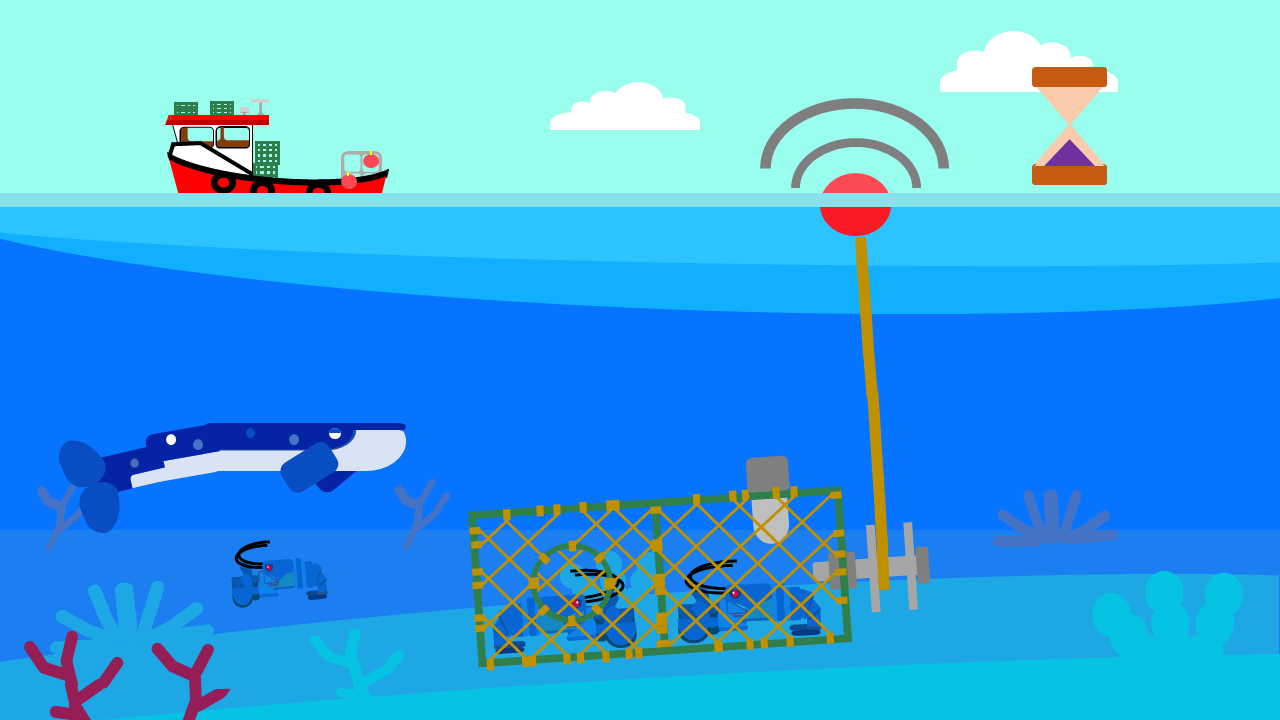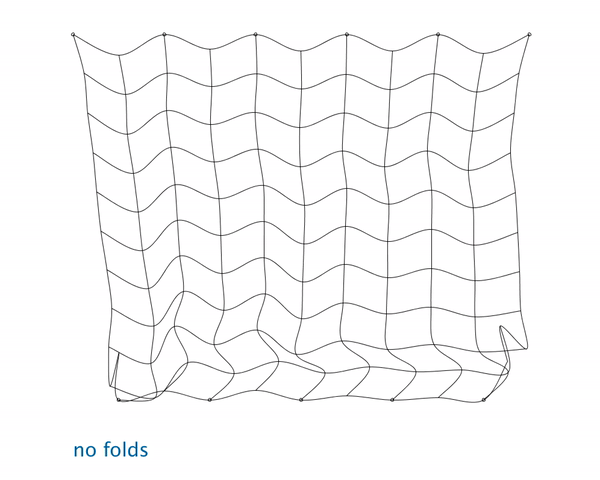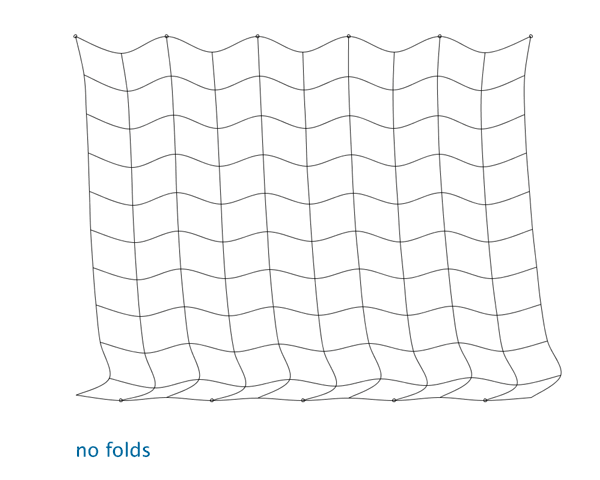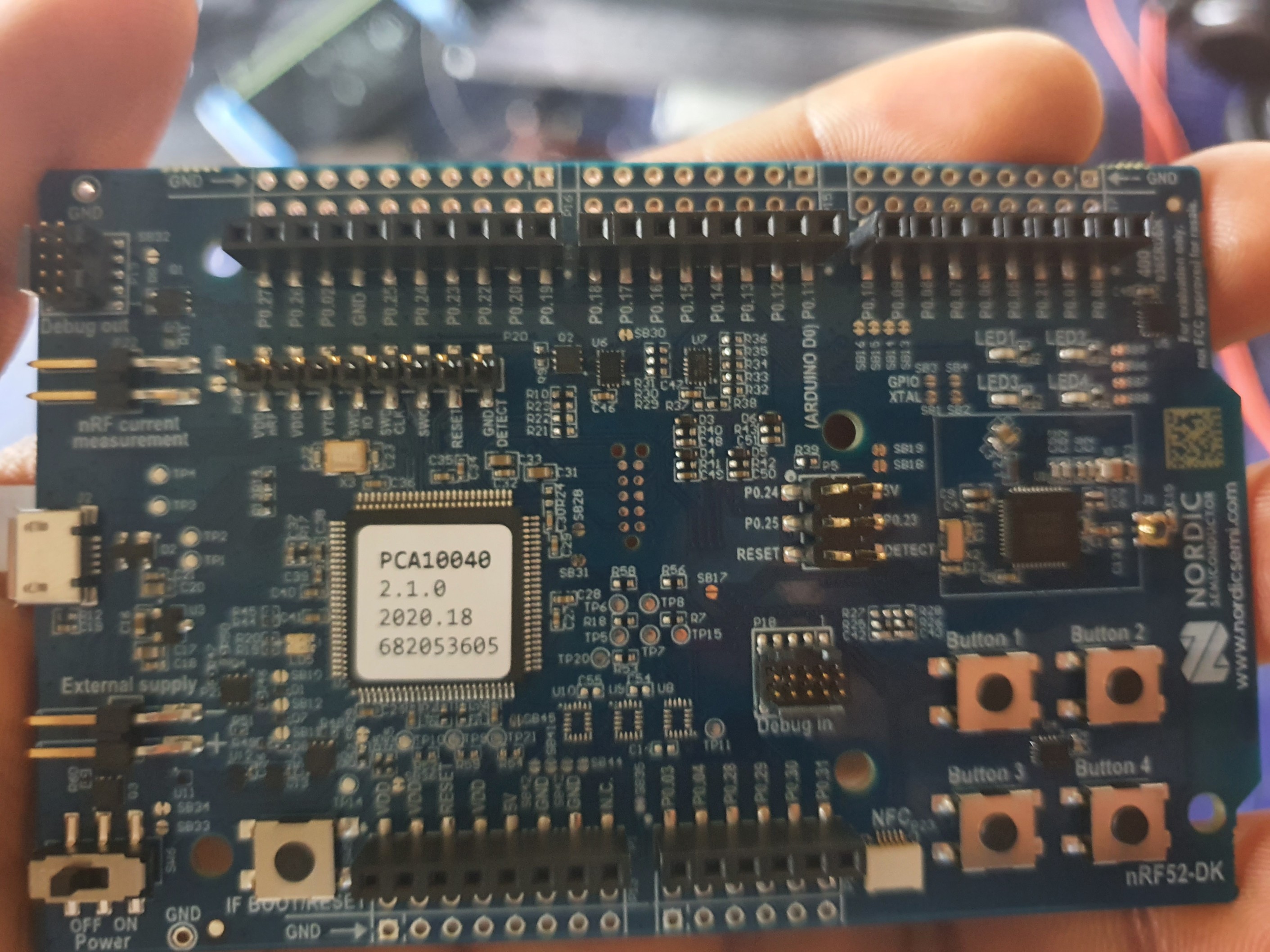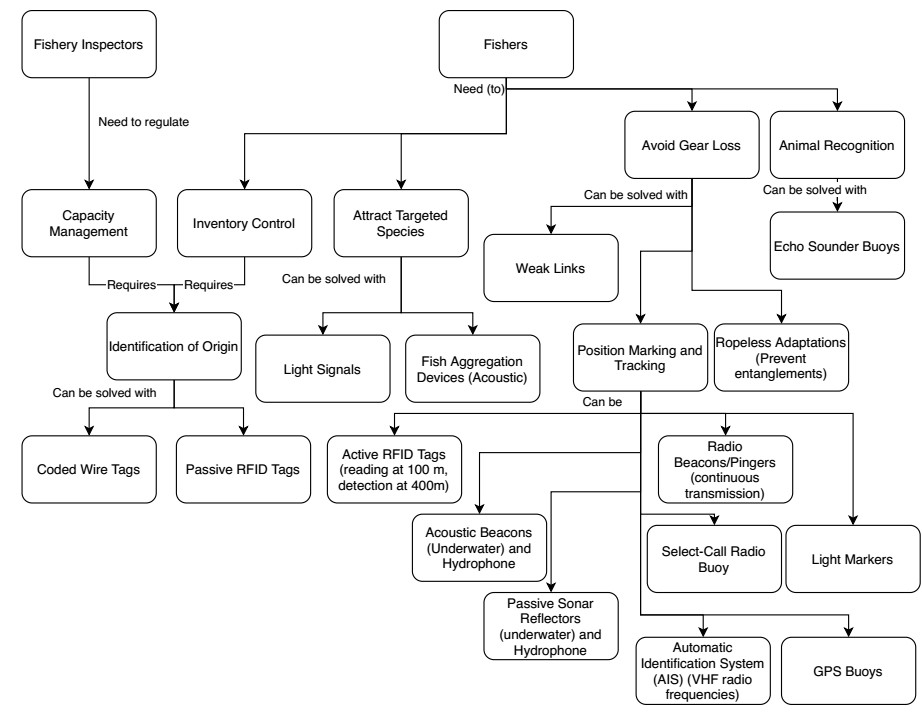-
Bycatch Agreements and Regulations
07/22/2020 at 04:43 • 0 commentsWhen fishing gear is lost, abandoned or discarded in the marine environment it continues to capture marine wildlife; the gear creates a risk of entanglement that leads to injuries and death.
Ghost gear is a source of marine mammal bycatch because the fishermen do not have access to the marine wildlife that is being caught, they can’t sell it or even release it from the gear.
NOAA Fisheries, also known as The National Marine Fisheries Service, is an office of the National Oceanic and Atmospheric Administration within the Department of Commerce of the United States. To reduce marine mammal bycatch associated with international commercial fishing NOAA Fisheries issued a rule that establishes a marine mammal bycatch criteria for U.S. imports in 2016. This rule not only marks and important step forward in marine mammal conservation, it also incentives fishers to adopt new techniques and technologies to lower the risk of bycatch.
Dolphins are a common bycatch in fisheries, especially in tuna fishing operations. To minimize dolphin fatalities the the Agreement on the International Dolphin Conservation Program (AIDCP) entered into force in February 1999. Their objectives are:
- Progressively reduce incidental dolphin mortalities in the tuna purse-seine fishery in the Agreement Area to levels approaching zero, through the setting of annual limits.
- Seek ecologically sound means of capturing large yellowfin tunas not in association with dolphins.
- Ensure the long-term sustainability of the tuna stocks in the Agreement Area
-
Initial Concept Review Presentation
07/20/2020 at 12:23 • 0 commentsJoin us for our initial concept review presentation to our nonprofit partner, Conservation X Labs! In the presentation, we will showcase our solution concept — how we reached that idea, and the reasons for it. We will be LIVE on YouTube at 12pm PT / 3pm ET. Get your tickets here.
![]()
We are looking forward to hearing the feedback from Conservation X Labs to see if our concept is headed in a useful direction, or if we need to gather further information.
You can see our one pager here, and the slides for our presentation here in the downloads section.
Special thanks to the @Supplyframe DesignLab team for their behind the scenes effort to make this happen. See you on the livestream!
-
Tech for Fishers: Survey!
07/18/2020 at 04:02 • 1 comment
Do YOU know a fisher? Know a friend who knows a fisher? We’d be super appreciative if they could fill out our Tech for Fishers survey!>>>>>>> bit.ly/fishers-survey <<<<<<<
We want to get the best understanding possible, so fisher’s input is incredibly valuable to this. Thanks in advance, Hackaday community, if anyone out there knows any fishers!
Did you know? Fishers often grow into their profession when it’s a family run operation. In a way, they could begin training by the time they are 7 years old!
-
Concept of Operations
07/13/2020 at 16:31 • 0 commentsProblem
How might we decrease the occurrence of marine species entanglements with fishing gear and decrease ghost gear creation, while making the commercial fishing process more intelligent for fisheries?
Since 2007 studies of removed gear from whales showed that 91% of cases involved vertical lines. Abandoned gear continues to catch fish and not only creates harmful environmental and ecological effects, it also causes socioeconomic consequences. In 2016 the removal of 34,408 abandoned pots led to gear efficiency gains and an additional 13,504 MT in harvest valued at US $21.3 million. Up to 10% of the world’s ocean plastic (and 70% of large pieces) comes from lost or abandoned fishing gear. The principal causes of lost fishing gear are unexpected position changes and entanglements.
Goal
The main goal is the prevention of gear loss. A great solution not only benefits the environment but also benefits the fishers, they can avoid the income losses that ghost gear creates and also benefit from an intelligent gear that collaborates to improve their efficiency.
Operations Process
- Fishers install the device in the gear, and define the maximum time that it will be underwater. Later, the fishers deploy the gear onto the water. The device stores its location and sends it to the server/app.
- The traps wait on the seafloor during the predefined time.
- The buoy is released if the time lapse ends or if the device detects that the trap has reached its full capacity. When the buoy gets to the surface it transmits its location.
- The fishers find the buoy and retrieve the gear.
-
Gear Comparison and Specifications
07/13/2020 at 01:47 • 0 commentsWhile narrowing in on our project scope, we were trying to determine the gear type should we specifically design for, and / or test with. We learned from @Oluwatobi Oyinlola ’s interview with a fisher that they primarily use passive gear.
When comparing two types of passive gear: traps & pots and longlines, they are diametrically opposed on value vs quantity of landings.
This makes for a dilemma in choosing a gear type as a prime candidate for testing and designing! Read on for more information, and gear distance specifications.
---------- more ----------In our meeting last week, @Giovanni shared some thoughts towards how to go about deciding: whatever gets us closer to testing a solution the fastest. Sometimes this can mean starting with a high-end solution to appeal to that market, then spreading it out to the more challenging areas.
There is also the option that we could try to make a generic solution across the different gear.
Research
Here is a data sample from the Canada Department of Fisheries & Oceans.
-------
Seafisheries landed value by province, 2018
All Groundfish (eg, halibut and cod) total = 410,344
Lobster total = 1,419,651
Crab total = 748,183
Lobster and crab have the greatest value
[source (Accessed July 7)]
-------
Seafisheries landed quantity by province, 2018
All Groundfish total = 228,239
Lobster total = 97,381
Crab total = 67,284
Groundfish has the greater quantity
[source (Accessed July 7)]
-------
Looking at data from the high seas (also known as international waters) shows the vast usage of longlines as well:
[source (Accessed July 7)]
-------
The most common gear reported to the Global Ghost Gear Initiative are nets, and Ghost Nets Australia has also found the majority of gear to be nets. [source: GNA Annual Report 2012 (Accessed July 12)]
[source (Accessed July 12)]
Gear Distances
Traps & pots
Depending on the type of vessel used, there are a variety of traps & pots configurations. Here is a sampling of a few - minimum, medium, and maximum. The diagrams are from Gulf of Maine’s Lobster Gear Configurations [source (Accessed July 12)], however I replaced the Fathom unit scale with metres.
[source (Accessed July 12)]
[source (Accessed July 12)]
[source (Accessed July 12)]
For general interest, a toggle is “a small float, generally less than 5 inches in diameter, deployed on a short gangion off the buoy line to prevent gear from getting snagged on the bottom” [source (Accessed July 12)]
Longlines
[source (Accessed July 12)]
[source (Accessed July 12)]
To Be Continued…
We haven’t decided yet. As we gather more information from fishers and our stakeholder, it will help the choice. Stay tuned!
-
Ghost Net Folding Experiment
07/12/2020 at 00:49 • 0 comments![]()
When looking at the ghost nets moved onshore in photos, there’s something that keeps coming to my mind: These structures are really good at folding.This observation spurred a thought: What if nets could fold in the water?
---------- more ----------Physics Simulation
![]()
I wanted to run an experiment to see what would happen. Using Processing and traer.physics (Github), I modified the basic cloth example to see what happens when folding vertically.Each node is attached to the other with a spring. The spring does not compress or extend very much, but is still movable across nodes — mimicking what we would see as a net’s behaviour. The arbitrary environment values for this simulation are:
float SPRING_STRENGTH = 0.2; float SPRING_DAMPING = 0.1; float GRAVITY_Y = 0.1; float DRAG = 0.01;Every other node on the top is fixed, same as the bottom with the sequence offset. This is similar to a gillnet setup with buoys and anchors.
The nodes that are coloured red ‘fold’ on to the blue ones. The ‘fold’ is done by moving the red nodes position on to the blue nodes. This experiment has a few different locations of the red nodes. The blue nodes are adjacent by + 1. For the last scenarios, there are green nodes that fold onto the red ones.
We can see the change in surface area:
![]()
It should probably be mentioned that the purpose of the experiment was to learn quickly. Meaning, the code for this was rather bruteforce - as in entering the exact numbers for the indices and without for loops.
Discussion
Nets, folded [source]
The nets in question include gillnets and trawler nets. When gear is lost, it becomes ghost gear. Eventually the gear will float to the surface or sink. When sinking, it can land on habitats on the seafloor. When floating, migrating marine species can become entangled.
When gear becomes lost, knowing the location of the gear and preventing the gear from harming wildlife is key. The time between location and retrieval could be long, depending on the distance the gear traveled, weather conditions, and the fisher’s scheduling. During this time, what else could be done?
Net covering a vast area [source]
What about folding? Folding would reduce surface area — which has benefits for either float or sink scenario.
How could it work? Maybe there could be robotic ‘starfish’ attached to the nets. These robots would be soft robots - operating by changing pressure moving to and from different areas. Each appendage could bend like a finger. As it is attached to the net, the net would fold it together. More about this idea in a future project log.
Net artwork in air [source]
As I was thinking about this, I remembered the suspended net artwork in Janet Echelman’s TED talk. They were able to make nets into visually compelling forms, sometimes with the help of external tension wires.
The fixed nodes, representing anchors and buoys, pose a difficulty when considering the implementation of such an approach. Would folding have to wait until the net is freed from the anchors to be effective? Could anchors be dynamic — perhaps using a buoyancy engine?
Next Steps
What if we could make ghost nets fold up automatically into something smaller? If it’s cost effective, would it be helpful? Additional fisher interviews could help to answer this question. As for next steps, conceptualization of the soft robotic ‘starfish’ will help to understand the possible magnitude of cost. Another cloth simulation with more nodes and folding in the interior of the net will be helpful to consider the folding idea further.
-
Microcontroller Choice
07/09/2020 at 06:54 • 0 commentsMicrocontroller Choice
The choice of microcontroller is particularly important in what we are planning to achieve, and of course there are several options, but we are pursuing the one that provide easy OTA firmware updates with an extremely low power functionality.
- STM32 with ESP8266 which can be designed to get firmware updates from the either a mobile application or an encoded firmware transfer in the flash memory which will be executed by the CPU.
- nRF52 series SoC is one of the chipsets by Nordic semiconductor designed for low energy solutions, the choice on nRF series will help us achieve our over the air firmware updates more faster with Bluetooth low energy DFU handler that would be added to the bootloader.
![]()
nRF52 Development Kit
Battery management is designed for rechargeable battery that monitors the charging cycles to protect and continually manage the charging circuit, which will constantly provide information and performance details based on the condition of the battery.
One of the mechanisms to use is a cell to cell balancing to achieve a uniform state of charge, other functionality is state-of-charge estimation, over-charging, and over-discharge protection.
Part of our plan for the implementation is to use Lithium-ion batteries rechargeable after 1-2 weeks through a direct AC to DC adapter.
-
Fishery Technology
07/08/2020 at 21:59 • 0 commentsNew technologies can benefit fishers and fishery inspectors, the following diagram relates recent technologies and how they can solve common problems that affect the industry and causes ghost gear.
![]()
Ropeless Adaptations for Fishing Gear are devices that reduce the risk of entanglements with vertical lines and ground lines. The develop applications contain the buoy and the rope inside the device and only release them when the fishers decide to retrieve the gear.
Radio Beacons (Radio Buoys) are radio transmitters that emit signals at predetermined intervals.
Select-Call Radio Buoy are radio transmitters that only emit signals when it receives a specific signal from its owner.
GPS Buoys are radio buoys that contain a Global Positioning System (or other satellite sensors).
Coded Wire Tags are magnetize tags, they typically are 0.25 mm in diameter and 1.1 mm in length. They contain binary or decimal numbers and can be detected with microscopes and read under a microscope.
RFID Tags are transponders that use Radio Frequency Identification. They can carry 2 KB of data. They can be passive or active. The first ones require a reader that creates an electromagnetic field; the second use a battery and can create their own field.
Automatic Identification System (AIS) is an automatic ship position and tracking system that has been used by Vessels, port authorities and maritime security. They use VHF radio frequency channels.
Fish Aggregation Devices (FADs) are devices created with the purpose to attract fish.
Echo Sounder Buoys use multi-frequency echo sounders for wider range detection of fish under and around the buoys.
Light Markers are devices that use light to indicate position of the gear at night. Also, different light signals are used to attract fish.
Acoustic Beacons/Pingers are transponders that continuously emit sounds at certain frequencies and are used for position marking underwater. Hydrophones are used to receive and the detect sound signals.
Passive Sonar Reflectors are devices that can enhance or reduce reflectivity of objects underwater. They are used for position marking.
Weak links are an existing solution of attachments from lines to buoys that can break under certain amount of force.
-
Research Report
07/03/2020 at 16:24 • 0 commentsAt a high level, the problem area is known as abandoned, lost, or otherwise discarded fishing gear (ALDFG) retrieval. This fishing gear is known as ghost gear, and falls into the wider scope of marine debris. Ghost gear has a tremendous impact on nature: leading to deaths of marine animals and harming the marine ecosystem. Additionally, it has an economic cost to the fisheries.
The goal of the Conservation X Labs Dream Team Challenge is to reduce "soak time", that is the time that fishing gear has to be left in the water unnecessarily. [1]
This time increases the chance of snag or loss. There are several gear types, the challenge addresses specifically two types: pots or longlines. [2]
A key insight that will guide the development of our solution will be that the technology must match the pace of fishing. Meaning, the solution will have to not be intrusive to their normal operations, it will need to be robust - as to not cause more ghost gear, and it must not use any additional time for which it would not have a return on. A preliminary user discovery interview conducted in Nigeria touched on these points as well.
In this research report, a better understanding of the problem will be given by touching on the following topics: Problem, Impact on Species, Root Cause Example, Barriers, Classification of Fishing Gear, Existing Solutions, and End-Users.
Read more below, or download the pdf here.
---------- more ----------Problem
Causes
Ghost gear’s capacity to entangle, injure and kill hundreds of species of marine animals on a large scale makes it a serious concern requiring urgent action.
There are several causes of ghost fishing gear:
- Damage and/or loss of gear through adverse weather conditions
- Snagging on marine environments
- Gear conflict (incidents where fishing vessels or their gear interact with each other, either accidentally or intentionally, causing damage)
- Gear abandoned at end of life due to lack of net disposal facilities or the high cost of disposal lack of ability to retrieve lost gear
- Abandonment to avoid detection when fishing illegally
- Human error
[3]
Soak Time
Soak time is one of the variables that is defined and changed to optimize the fishing operations. There are several studies that relate the influence and effects of different soak times and the catching efficiency of the gear. For the fishermen it is important to establish the optimal time that the gear needs to be in the water. Usually this time depends on its type and the target species, but that time increases if any of the following situations occurs:
1. The gear is lost. When that happens it becomes ghost gear. This represents 10% of the world's ocean plastic.
2. The gear is badly located.
3. The gear has already caught the desired amount of fish, but is left in the ocean until the time arrives to retrieve the gear.
Economic Cost
Ghost gear is particularly damaging because it continues to execute its purpose of capturing fish well after being lost to fishers. This results in four areas of cost:
- Decreased harvests
- Habitat damage
- Navigational hazard
- Replacement gear
[4]
Impact on Species
Figure 01: This female right whale died off the Canadian coast this summer after dragging crab traps for days. NOAA/NEFSC/PETER DULEY
All marine life can be affected by entanglement of ghost gear and bycatch. This includes species such as sea turtles, seals, sea birds. Of particular interest are Right Whales, as they are one of the world’s most endangered whales. Shockingly, 82% of North Atlantic right whales have become entangled at least once [5].
The North Atlantic Right Whales were hunted to near extinction in the 1750’s for their oil, meat and bones. Now they become entangled in fishing gear, ultimately leading to death. The population is decreasing rapidly, so much so that they may be functionally extinct by 2040 if more effort is not done to save them. [6]
We can compare the North Atlantic Right Whale to its Southern Hemisphere counterpart. These Right Whales rebounded to 15,000 animals, a population growth of 6% annually. Their primary cause of death is old age in their 80s. Compared to the North Atlantic Right Whales, the Southern Hemisphere Right Whales do not migrate through busy areas. [7] The North Atlantic Right Whales swim through shipping lanes and fishing gear. This comparison shows the impact that the industrialized ocean is having on Right Whales.
Root Cause
Flow Chart
The diagram below shows the root causes of unnecessary soak time, and what can be the effects of this.
Figure 02: Root Causes
Case Study: Lobster Fishing
As an example case, the recent history of lobster catch in eastern North America illustrates a root cause for the increase in ghost gear.
Since 2000, lobster catch in the U.S. has increased. The reason for this increase is more offshore fishing than nearshore fishing. Offshore fishing is a more industrial endeavour, using larger traps, set in deeper water, and using stronger ropes. The vessels for offshore fishing are often twice as large as the lobster dayboats frequenting nearshore fishing. [8] As the commercial fishing industry was expanding, the growing lobster catch resulted in more vertical ropes in areas where Right Whales are found. [9]. To give a sense of scale to the lobster fishing industry, in 2018, 147.6 million pounds of lobster were landed coastwide, representing a $630 million ex-vessel value. [10]
Figure 03: Lobsters fished offshore vs nearshore over time [11]
The Gulf of Maine / Georges Bank stock is not overfished. Rather, the stock abundance has increased since 1979 and at an accelerated pace since 2007. Current stock abundance is at an all-time high and recruitment has remained high between 2008 and 2013 [12]. The population of lobster is not disappearing, instead it is the location that has changed.
The way we determine stock size is by catch-per-unit-effort, also known as catch rate. It is frequently the single most useful index for long-term monitoring of a fishery. Catch rates by boat and gear categories, often combined with data on fish size at capture, permit a large number of analyses relating to gear selectivity, indices of exploitation and monitoring of economic efficiency. [13]
The location has changed due to warming sea surface temperatures. This forces the lobster to higher latitudes than previously. Although ocean temperatures worldwide have risen 0.12 deg C each decade since 1980, this is not the case for offshore in the U.S. Northeast region (where the lobsters are). From 1982 to 2006, the sea surface temperatures in that region increased by twice the global rate, according to the National Climate Assessment. The Gulf of Maine is a hotspot, where it’s predicted the sea surface temperatures are warming faster than anywhere else on the planet, to an estimated possible between 2 - 4 deg F by the end of the century (2020) [14]
Figure 04: Sea surface temperature trends and map of change [15]
This increase in sea surface temperature is why lobsters are moving. Lobsters are stressed after 20 deg C, where they then experience respiratory and immune problems, leading to shell disease and less chance to successfully reproduce. [16]
Classification of Fishing Gear
Types of Gear
There are two different types of gear: pots and longlines. Longlines can be bottom longlines or pelagic longlines.
Traps and pots are submerged three-dimensional wire or wood devices that permit organisms to enter the enclosure but make escape extremely difficult or impossible. Their target species are fish (scup, black sea bass and eels), crustaceans and mollusks (crabs, lobsters and whelk). Traps and pots use vertical lines that run from them to a buoy in the surface, and this creates a risk of entanglement for turtles and marine mammals.
Figure 05: Traps and pots illustration. [17]
Bottom longlines are a type of fishing gear that uses baited hooks attached to a mainline weighted to the seafloor with buoy lines marked by flags on either end. Their target species are sharks, halibut, flounder, sole, and other groundfish. They create a risk of entanglement with the vertical lines and hooks.
Figure 06: Bottom longline illustration. [18]
Pelagic longlines are a type of fishing gear that consist of a mainline, gangions, and baited hooks. Their target species are tuna, swordfish and other Pacific billfish. They create a risk of entanglement with the vertical lines and hooks.
Figure 07: Pelagic longline. [19]
All the mentioned types of gear create a risk of entanglement with the animals in the surrounding environment. All of them contain a main vertical line attached to a buoy, but also they create a risk (to a lesser degree) with their hooks (longlines) and groundlines (traps and pots). The figure below illustrates the risks caused by the types of fishing gear.
Figure 08: Gear types and their associated risks
How Traps Work
The below images [20] show the inner workings of a trap. Bait is placed inside the trap, which lures the lobster in. If the lobster is too small, then it can escape through an escape vent. Lobsters then try to leave the trap by travelling through a funnel. This leads them into an area that is challenging to escape from, and is usually where the catch will be found when retrieved.
[20]
Barriers
When we consider the scale and impact of this problem, this question arises: Why hasn’t more technology been adopted for these problems already? The report, Technologies for Improving Fisheries (2018) shares relevant insights towards this. The most pertinent examples from the report are included below.
- Lack of drivers
“Many fisheries lack drivers for monitoring, such as legal mandates or strong economic incentives. Moreover, monitoring programs are difficult to implement for a number of reasons: fishermen who have been fishing without restrictions may resist being held accountable to fishery regulations; the costs of monitoring may seem prohibitive; privacy concerns may drive opposition to monitoring; and prosecutorial systems may not generate sufficiently severe penalties for infractions, making monitoring seem futile.” [21]
- Legal mandate required
“A legal mandate to monitor is often a critical component in implementation and can result in fishery managers and fishermen working together, but this alone is often not enough. Stakeholders generally need to be incentivized to adopt a monitoring system beyond the threat of punishment, which is often ineffective or even non-existent in certain contexts; ownership of the idea that monitoring will lead to better fishing is obviously preferable, and this can be achieved by using participatory processes to co-create monitoring goals and design monitoring systems. Demonstrating and otherwise communicating the benefits of monitoring for fishermen—often in the form of higher fish prices, increased catches and increased sustainability—can help to achieve stakeholder buy-in.” [21]
- Positive outcomes
“Positive outcomes of monitoring can reinforce buy-in and willingness to participate in improving fisheries accountability. For example, if fisheries monitoring strengthens fishermen’s rights by ensuring that no illegal fishing is taking place, and that scientific data are being used to manage the fishery, participants will likely approach monitoring in a positive manner.” [21]
- Benefits exceed costs
“It is important to strive to ensure that the benefits exceed the costs of implementing a particular monitoring program. Many fisheries probably cannot afford to implement an intensive monitoring system that involves the use of cameras in integrated systems that generate highly detailed data for management.” [21]
Existing Solutions
Overview
The challenge proposes 3 possible solutions:
1. Notify the gear has been deployed in an undesirable location.
2. Communicate that the fishing gear has moved to a different location, to avoid it becomes ghost gear.
3. Notify that the target species has been caught.
[22]
A 2015 study by Gilman, showed that established techniques to reduce the impacts of ghost gear are not widely implemented. The categories in this study give insight into potential technical solutions to reducing ghost gear impacts. [23]
In the broad perspective, here are a variety of technological solutions from the Technologies for Improving Fisheries Monitoring report.
[21]
In the sections below are additional solutions of interest that have already been developed.
Ropeless Fishing Gear
Ropeless fishing is a technique that removes the vertical line that is a part of different types of gear and leads to a buoy on the surface. The fishermen have a visual reference of the gear's location, and also helps to retrieve the gear from the water. [24]
Figure 09: Step-by-step depiction of a pop-up, or 'ropeless' system. [25]
How effective is the solution?
A ropeless gear solution helps to reduce the entanglements. The challenge addresses specific types of fishing gear (pots and longlines), and all of them create a risk of entanglement because of the use of vertical lines. The principal objective of a ropeless gear solution is to remove the mainline that goes to the surface. Since the entanglements directly create ghost gear, and that gear represents 10% of the ocean’s plastic, a ropless solution directly reduces the soak time. [26]
The ropeless solution evaluated in the report includes a remote localization system. This functionality is a key benefit. Most of the ropeless solutions include a remote localization system. [27]
This type of system is useful for the fishermen when the buoy is released. An underwater system is useful to keep track of the localization at all moments. This aspect is required by Fishery Inspectors, and any viable, long term solution needs to take them into account. [28]
Products and Projects:
- 5112 Ropeless Fishing System. [29]
- Pop-Up Buoy Recovery System. [30]
- Ropeless Fishing studies and experiences from Desert Star Systems [31]
- The Ropeless Workshop Report from the Woods Hole Oceanographic Institution (2018) [31]
From the last experiences of Desert Star Systems with pop-up gear tests, the fishermen manifested two main concerns:
- The technology must match the pace of fishing that they are currently able to achieve, Any increase in time caused by the new technology creates an increase in working hours to achieve the same income.
- The release and recovery system must be robust, if the buoy doesn’t pop up the system creates losses of income and creates more ghost gear.
[32]
Weak Links
Weak links are an existing solution of attachments from lines to buoys that can break under a certain amount of force. Related to this solution are bio-degradable options for ropes and traps. See below for images detailing weak links, these images are from [33].
Note: The following sections were provided to us by Sam Kelly from Conservation X Labs
Gear Marking
Identify ownership and increase visibility. Being able to trace an owner back to lost gear reduces likelihood of intentional dumping/abandonment and identify practices that lead to unintentionally lost gear. It may also present an opportunity to increase the traceability of seafood and limit the capacity.
Coded Wire Tags (CWT)
Used in juvenile salmon – laser etched ID, detected by specialized readers (T-Wands) and read under microscope. Single study for tracing origin of fishing gear (ropes in fixed gear) Krutzikowsky et al (2009). $18USD per km of rope (0.25c per tag) and likelihood of identifying tag is 90%. Concluded too expensive due to depths.
Figure 10: The standard coded wire tag (1.1 mm x 0.25 mm) as it appeared in a fingertip [34]
Passive RFID Tags
Can carry 2 KB of data, but can be advanced and add GPS, time etc.
Applications:
- PIT Tags (Passive Integrated Transponder)
- NOAA supports research for advanced gear marking technologies
- Rope Tagging – BioMark Inc. (Boise, ID)
- All readable for inshore gillnet and lobster pot, only 54% offshore lobster pot
- NOAA supported research on “Super Smart Tape”
- Capacity monitoring
- Amount of gear is limited in fisheries so tags are ascribed to permit numbers and they are starting to incorporate RFID
- GPS Location is read when the RFID is scanned – allowed better recording of areas where fishing occurs
Figure 11: Cable-tie style tags typically used in lobster pots in Maine, USA.
Figure 12: The quarter-size RFID tag used for crab pots by Quinault Indian Nation (NWIFC, 2015). [34]
Technology to Track Gear Position
Tracking the location of gear position involves the use of smart buoys that can communicate long distances to fishermen. The use of this gear transcends fishing techniques but is most commonly used in pelagic fisheries such as longlines and seine nets where FADs are used.
For example, Japanese Pelagic Longlines can be 70NM in length. They have radio buoys for retrieval with GPS, sonar and solar panels incorporated. FADs are another common use for tracking buoys - 75% of purse seine nets now use FADs (Lopez et al 2015) (including tuna – half (Miyake et al., 2010). There is growing fear of ecological impact (Davis et al, 2014) of FADs but there is now 105,000 drifting FADs (primarily for tuna purse seine) (Baske et al 2012). The top five manufacturers put out 47,500-70,000 buoys a year.
AIS (Automatic Identification System)
AIS is an automatic ship position and tracking system widely used by ships.
Classes:
- Class A – 20-25NM
- Class B – 7-8NM
- Search and Rescue Transmitters (SARTs) (3-4NM)
- Aid to Navigation (ATON)
- Shore-based stations
- S-AIS (Satellite AIS)
Figure 13: The AIS Class B drift marker designed by Aanderaa Data Instruments AS (www.aadi.no) that was primarily used for tracking oil spills. [34]
Only 1% of the 1.3 million fishing vessels carry a Class A system. There are several unused data slots that could be used for marking fishing gear (and presumably other things). There are restrictions within the US about using AIS for non-vessel purposes.
Use VHF frequencies: Ch. A: 161.976 MHz, Channel B: 162.025 MHz
Companies:
- SeaFi – hold the record for longest transmission without satellite or cellular network
- AADI AIS Drifter Buoy – can be received from Class A and Class B AIS receivers and shore-based stations. Rechargable battery lasts 7 days.
- Em-Trak - $500
- SRT Marine Technology - $500
- True Heading AS - $500
- Matsutec - $200
- Quark-Elec Online AIS Store: (includes “SeaCall” which can be used for Skype) $50-700
NOAA is experimenting with virtual buoys (AIS transmitter in different location send location of e-buoy, so that boats can see vessel)
Figure 14: Examples of radio buoys for longlines from Kato Electronics Co. Ltd (Kaohsiung, Taiwan). Antenna not included. From: http://www.radiobuoy.com. [34]
Radio Buoys
Two types: 1) Constantly transmit 2) Only transmit when called (Sel-Call)
Companies
- Kato Electronics: KTR-17/18, range: couple of 100 NM, emit signals with 30 sec repetition 3 min rest
- Dong Yang Engineering: PRSC-30 lasts 10x longer. Only emits signal when it receives signal from owner vessel
- Marine Instruments AS: Satellite Communication Buoy
Figure 15: An example of a solar-powered satellite FAD buoy from Marine Instruments AS with some advertised features (www.marineinstruments.es). [34]
Finding Lost Gear
Pingers/Transponders
Used to recover ghost/lost gear
Gearfinder 700 – An acoustic recovery system
Deepsea Launcher System – Acoustic Release System for fishing gear
Passive Sonar Reflectors
Devices that are engineered to enhance or reduce acoustic signal.
SonarBell (Subsea Asset Location Technologies) – Previous military tech, material creates a signal significantly greater than a solid reflecting sphere. Works frequencies 8-140kH
Figure 16: The Deepsea Launcher System (DLS) from Scatri of France. A. The gillnet in fishing condition (the buoy submerged 15-40 m the surface. B. The buoy emerged from underwater during retrieval. C. The buoy. From http://www.scatri.com. [34]
End-Users
Preliminary Discovery Interview Conducted
Discussed with one of the famous tribe of fishermen in Nigeria about which gear they use the most. He prefers the passive gear because it does not need to be dragged, pulled or towed to capture fish. The catch is recovered by simply removing the gear from the water after a time period. No energy is expended on towing, pulling or dragging of gear. This is the simplest gear employed for fishing. The requirements are line and baited hook. Hooks vary enormously in shape, size, type of point, thickness of wire and type of end of the shank.
User Benefits
Who are your users? Who is willing to pay for the solution?
The principal users are the fishermen. The Ropeless Workshop Report from the Woods Hole Oceanographic Institution (2018) discusses the following benefits for the fishermen:
- Never buy end lines again for some ropeless approaches.
- Significant reduction in lost gear.
- Gear position is still apparent using technology, but gear identity only known by gear owner and enforcement.
- Less gear movement from current and tidal drag on end lines and buoys.
- Fewer interactions with vessels.
- Some ropeless options may be safer to retrieve
- Gear identity and location can be monitored remotely
- Better information for regulators (for example fishing effort)
[35]
References
Apologies for some duplicate entries
[1] Design Brief Conservation X Labs Dream Team Challenge. Available at: https://cdn.hackaday.io/files/8533365075872/design-brief-conservationxlabs-dream-team-challenge-wp.pdf (Accessed: 1 July 2020)
[2] Fishing Gear and Risks to Protected Species (2020). Available at: https://www.fisheries.noaa.gov/national/bycatch/fishing-gear-and-risks-protected-species (Accessed: 1 July 2020)
[3] 1. Macfadyen, Graeme;Huntington, Tim;Cappell, R. Abandoned, lost or otherwise discarded fishing gear. FAO Fisheries and Aquaculture Technical Paper 523 523, (2009). (Accessed 30 June)
[4] https://www.nature.com/articles/srep19671 (Accessed 4 July)
[5] source 22 from here - Ghosts Beneath the Waves — World Animal Protection (report here) (Accessed June 30)
[6] https://www.biologicaldiversity.org/species/mammals/North_Atlantic_right_whale/index.html (Accessed July 3)
[7] https://e360.yale.edu/features/already-on-brink-right-whales-are-pushed-closer-to-the-edge (Accessed July 3)
[8] https://www.pewtrusts.org/en/research-and-analysis/articles/2019/04/25/time-is-running-out-to-save-right-whales (Accessed June 30)
[9] https://www.pewtrusts.org/en/research-and-analysis/articles/2019/03/07/saving-endangered-right-whale-demands-new-approach (Accessed June 30)
[10] http://www.asmfc.org/species/american-lobster (Accessed June 30)
[11] https://www.pewtrusts.org/en/research-and-analysis/articles/2019/04/25/time-is-running-out-to-save-right-whales (Accessed June 30)
[12] http://www.asmfc.org/species/american-lobster (Accessed June 30)
[13] http://www.fao.org/3/Y2790E/y2790e02.htm#TopOfPage (Accessed July 1)
[14] https://www.climate.gov/news-features/climate-and/climate-lobsters (Accessed June 30)
[15] https://www.climate.gov/news-features/climate-and/climate-lobsters (Accessed June 30)
[16] https://www.climate.gov/news-features/climate-and/climate-lobsters (Accessed June 30)
[17] Fishing Gear: Traps and Pots (2020). Available at: https://www.fisheries.noaa.gov/national/bycatch/fishing-gear-traps-and-pots (Accessed: 1 July 2020)
[18] Fishing Gear: Bottom Longlines (2020). Available at: https://www.fisheries.noaa.gov/national/bycatch/fishing-gear-bottom-longlines (Accessed: 1 July 2020)
[19] Fishing Gear: Pelagic Longlines (2020). Available at: https://www.fisheries.noaa.gov/national/bycatch/fishing-gear-pelagic-longlines (Accessed: 1 July 2020)
[20] http://www.eregulations.com/massachusetts/fishing/saltwater/lobstercrab-trap-requirements/ (Accessed July 3)
[21] Technologies for Improving Fisheries (2018) https://www.edf.org/sites/default/files/oceans/Technologies_for_Improving_Fisheries_Monitoring.pdf (Accessed 1 July)
[22] Design Brief Conservation X Labs Dream Team Challenge. Available at: https://cdn.hackaday.io/files/8533365075872/design-brief-conservationxlabs-dream-team-challenge-wp.pdf (Accessed: 1 July 2020)
[23] Eric Gilman, “Status of International Monitoring and Management of Abandoned, Lost and Discarded Fishing Gear and Ghost Fishing,” Marine Policy 60 (October 1, 2015): 225–39, https://doi.org/10.1016/j.marpol.2015.06.016.
[24] Consortium, R. and Consortium, R. (2020) Background – Ropeless Consortium, Ropeless.org. Available at: https://ropeless.org/background/ (Accessed: 1 July 2020)
[25] Simke, A. (2020) New ‘Pop-Up’ Fishing Gear Could Reduce Whale Entanglements, Forbes. Available at: https://www.forbes.com/sites/ariellasimke/2020/03/14/new-pop-up-fishing-gear-could-reduce-whale-entanglements/#1095fdb02b8c (Accessed: 2 July 2020)
[26] Design Brief Conservation X Labs Dream Team Challenge. Available at: https://cdn.hackaday.io/files/8533365075872/design-brief-conservationxlabs-dream-team-challenge-wp.pdf (Accessed: 1 July 2020)
[27] Ropeless Workshop Report. Available at: https://ropeless.org/wp-content/uploads/sites/112/2018/03/Ropeless_Workshop_Report.pdf (Accessed: 2 July 2020)
[28] Desert Star Systems LLC Technical Proposal Topic Ropeless Fishing. Available at: https://static1.squarespace.com/static/5c49f2807e3c3a3eb6d75875/t/5c5b7494085229ad86f5cec5/1549497513314/Desert+Star+Systems+LLC+-+Technical+Proposal+-+Topic+9-2-04+Ropeless+Fishing.pdf (Accessed: 2 July 2020)
[29] 5112 Ropeless Fishing System (2020). Available at: https://www.edgetech.com/product/5112-ropeless-fishing-system/ (Accessed: 1 July 2020)
[30] System and Inc., D. (2020) Pop-Up Buoy Recovery System | Ocean News and Technology, Ocean News and Technology. Available at: https://www.oceannews.com/offer/pop-up-buoy-recovery-system (Accessed: 1 July 2020)
[31] Ropeless Conversion | Desert Star Systems (2020). Available at: https://www.desertstar.com/es_MX/ropeless-fishing/considerations (Accessed: 2 July 2020)
[32] Simke, A. (2020) New ‘Pop-Up’ Fishing Gear Could Reduce Whale Entanglements, Forbes. Available at: https://www.forbes.com/sites/ariellasimke/2020/03/14/new-pop-up-fishing-gear-could-reduce-whale-entanglements/#1095fdb02b8c (Accessed: 2 July 2020)
[33] NOAA Atlantic Large Whale Take Reduction Plan - Supplements https://www.maine.gov/dmr/science-research/species/lobster/documents/plansupplements8-14.pdf (Accessed: July 4 2020)
[34] New Technologies for Marking of Fishing Gear. Available at: http://www.fao.org/fishery/docs/DOCUMENT/ec-marking/Inf3.pdf (Accessed: 5 July 2020)
[35] Ropeless Workshop Report. Available at: https://ropeless.org/wp-content/uploads/sites/112/2018/03/Ropeless_Workshop_Report.pdf (Accessed: 2 July 2020)
2021 HDP Dream Team: EJA
Learn more about Team EJA's intelligent buoy, and how their solution will help the global fight against ghost gear.
 Supplyframe DesignLab
Supplyframe DesignLab